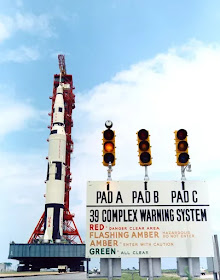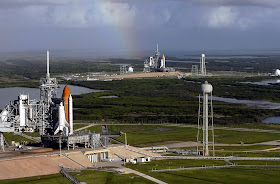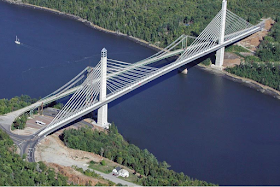Upstream span: 1958 with four lanes
Downstream span: 1988 with six lanes, two of which are reversible HOV lanes. (HOV = High-Occupancy Vehicles Typically, HOV means at least two people in the vehicle.)
"The older span was the longest continuous truss bridge in the world when it opened. The 3,019 foot long truss superstructure and 1,575 foot long main span still rate as some of largest continuous truss bridges on the planet." [Weeks III] As of 2013, tolls are no longer collected. [Bridge Hunter comment]
 |
| Jonathon Gilliland posted Different view of the GNO bridge |
 |
| Louisiana Memories posted Reynold Sparrow: That look more like 1983 than 1984. Reggie Ford: Reynold Sparrow the picture was shot from inside of a gondola in 1984 World Fair. Construction started 1981 it was finished in 1988 Lloyd Scott Hardin shared |
Greater New Orleans Bridge (now known as the Crescent City Connection) under construction in 1984
Steve Robinson posted several photos with the comment:
Will T Henson Ironworkers didn’t have to tie off up until about 1993-94 somewhere in there.
Crescent City Connection- New Orleans, Louisiana, UnitedCecil Douglas Awesome pictures. Notice the iron workers not tied off. Back in the day.
The Crescent City Connection (CCC), formerly the Greater New Orleans Bridge (GNO), refers to twin cantilever bridges that carry U.S. Highway 90 Business (US 90 Bus.) over the Mississippi River in New Orleans, Louisiana, United States. They are tied as the fifth-longest cantilever bridges in the world. Each span carries four general-use automobile lanes; additionally the westbound span has two reversible HOV lanes across the river.
What later became known as the Crescent City Connection was the second bridge to span the Mississippi south of Baton Rouge, the first being the Huey P. Long Bridge, a few miles upriver from the city, and it is the first bridge across the river in New Orleans itself.
The Mississippi River Bridge Authority, known since 1989 as the Crescent City Connection Division (CCCD), began construction of the first span in November 1954, which opened in April 1958 as the Greater New Orleans Bridge. At its opening, the bridge was the longest cantilever bridge in the world although in terms of main span length, it was third, after the Forth Bridge and the Quebec Bridge. It carried two lanes of traffic in each direction and spurred growth in the suburban area known as the West Bank (named for its location on the western bank of the river although it is geographically southeast of New Orleans). Construction of the second span began in March 1981. Despite promises that it would be ready for the 1984 Louisiana World Exposition, it did not open to traffic until September 1988. The second span was originally designated as the Greater New Orleans Bridge No. 2. Both bridges were designed by Modjeski & Masters, Inc.. As soon as the new span was opened, the old span was temporarily closed in phases to replace the asphalt-on-steel deck with concrete. All the exits and entrances to the bridge were replaced as well.
Will T Henson Ironworkers didn’t have to tie off up until about 1993-94 somewhere in there.
 |
| 9 |
 |
| 1 |
 |
| 2 |
 |
| 3 |
 |
| 4 |
 |
| 5 |
 |
| 6 |
 |
| 7 Bridges Now and Then posted "Greater New Orleans Bridge (now known as the Crescent City Connection) under construction in 1984." (Steve Robinson) |
 |
| 8 |
 |
| 10 |
 |
| Derby Gisclair posted Construction first began in November 1954 on the Greater New Orleans Bridge which when it opened in April 1958 was the longest cantilever bridge in the world. It was the first bridge in the city of New Orleans to cross the Mississippi River. A second bridge was built in between 1981 and 1989 and together the two bridges are known as The Crescent City Connection. Tolls were collected on the bridge from 1958 through 1964 and then again from 1989 through 2013. Joe Owens: When they met in the middle of the new bridge they were about 3 inches off. So they took dry ice and put it on one side of the steel to get it to warp over, then they bolted it. |
 |
| RiverWorks Discovery posted |
The sun  is shining on the Crescent City twin bridges that connect the City of New Orleans to the West Bank over the Mighty Mississippi.
is shining on the Crescent City twin bridges that connect the City of New Orleans to the West Bank over the Mighty Mississippi.
This picture sort of symbolizes a sense of hope, that bridges going in the opposite direction, can still work together to bring the same positive result, something we desperately need right now.
 |
| RiverWorks Discovery posted The Crescent City Connection Bridges, CCC, seen at here at night connects Greater New Orleans to what is commonly known as the West Bank. The right descending bank of the Mighty Mississippi River! The twin cantilever bridges are the fifth-longest cantilever bridges in the world. |
 |
| We Work the Waterways posted Marquette Transportation Company's M/V THERESA L. WOOD looking up at The Greater New Orleans Bridges, now known as the Crescent City Connection or CCC. The Big Easy is on the right looking upriver and what is known as The West Bank is on the left. The CCC is all lit up with a gorgeous purple reflection in the Mississippi River. Courtesy of Captain John Vaughn. |
 |
| Allek Wade commented on the above post |















































